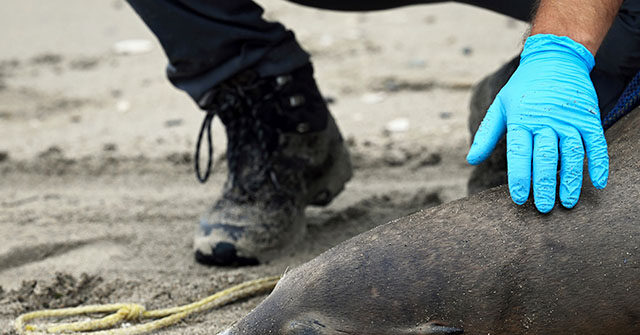More than 400 mammals have been reported stranded or sickened along the state’s central coast since June, according to the Marine Mammal Center, with more than two-thirds of them dying. Many more likely died at sea or expired before anyone spotted them, the rescue group believes.
The culprits? A corkscrew bacteria called leptospirosis, toxic algae blooms, and changes in the food supply, according to the Los Angeles Times.
The Times story described an emaciated sea lion found on a beach north of Santa Cruz, the animal in a self-embrace from the bacteria that damages mammals’ kidneys and inflames their gastrointestinal tracks.
“That’s a classic sign of lepto,” said Giancarlo Rulli, a spokesperson with the center, pointing to the young animal’s self-embrace. “They hold their stomach just like that. Like a sick child with a bellyache.”
Scores of sea lions have shown those symptoms over the summer on California beaches, according to an earlier report.
The disease can also be fatal for dogs. Since it is transmitted through contaminated water, experts urge Californians to keep their canines on leashes and not let them approach marine animals.
The center rescues the sick sea lions and takes them in for examinations and diagnostic tests. The animals are treated with antibiotics and other drugs. It can take a few weeks to a few months for them to recover.
Whether or not the other factors – poisonous algal blooms off the central and southern coasts and changes in the food supply – occurring at the same time are related is the subject of scientific inquiry.
“We’re trying to build our understanding of how ocean conditions relate to the occurrence of disease,” Jamie Lloyd-Smith, an ecologist and evolutionary biologist at UCLA told the Times. “But it’s a work in progress. And the world is changing quickly underneath our feet.”
Katie Prager, a disease ecologist at UCLA said the first outbreak of leptospirosis in sea lions was reported along the West Coast in 1970.
By the 1980s, marine groups were keeping comprehensive records. They found that the bacterium tends to cause small, annual outbreaks that start in late summer and last just a month or two, according to the Times report.
Every three to five years, however, they’d see a big outbreak in which scores of animals got sick, Rulli said.
Lloyd-Smith and others say population dynamics likely drive the higher case years, such as when young animals come in contact with the bacteria.
Leptospirosis typically kills about two-thirds of the animals it sickens.
Contributor Lowell Cauffiel is the best-selling author of the Los Angeles crime novel Below the Line and nine other crime novels and nonfiction titles. See lowellcauffiel.com for more
Breitbart News
Read the full article .


